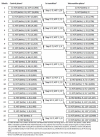Effects of emergency obstetric care training on maternal and perinatal outcomes: a stepped wedge cluster randomised trial in South Africa
- PMID: 31798985
- PMCID: PMC6861119
- DOI: 10.1136/bmjgh-2019-001670
Effects of emergency obstetric care training on maternal and perinatal outcomes: a stepped wedge cluster randomised trial in South Africa
Abstract
Introduction: Two-thirds of maternal deaths and 40% of intrapartum-related neonatal deaths are thought to be preventable through emergency obstetric and newborn care (EmOC&NC). The effectiveness of 'skills and drills' training of maternity staff in EmOC&NC was evaluated.
Methods: Implementation research using a stepped wedge cluster randomised trial including 127 of 129 healthcare facilities (HCFs) across the 11 districts in South Africa with the highest maternal mortality. The sequence in which all districts received EmOC&NC training was randomised but could not be blinded. The timing of training resulted in 10 districts providing data before and 10 providing data after EmOC&NC training. Primary outcome measures derived for HCFs are as follows: stillbirth rate (SBR), early neonatal death (ENND) rate, institutional maternal mortality ratio (iMMR) and direct obstetric case fatality rate (CFR), number of complications recognised and managed and CFR by complication.
Results: At baseline, median SBR (per 1000 births) and ENND rate (per 1000 live births) were 9 (IQR 0-28) and 0 (IQR 0-9). No significant changes following training in EmOC&NC were detected for any of the stated outcomes: SBR (adjusted incidence rate ratio (aIRR) 0.97, 95% CI 0.91 to 1.05), iMMR (aIRR 1.23, 95% CI 0.80 to 1.90), ENND rate (aIRR 1.04, 95% CI 0.92 to 1.17) and direct obstetric CFR (aIRR 1.15, 95% CI 0.66 to 2.02). The number of women who were recognised to need and received EmOC was significantly increased overall (aIRR 1.14, 95% CI 1.02 to 1.27), for haemorrhage (aIRR 1.31, 95% CI 1.13 to 1.52) and for postpartum sepsis (aIRR 1.86, 95% CI 1.17 to 2.95).
Conclusion: Following EmOC&NC training, healthcare providers are more able to recognise and manage complications at time of birth. This trial did not provide evidence that the intervention was effective in reducing adverse clinical outcomes, but demonstrates randomised evaluations are feasible in implementation research.
Trial registration number: ISRCTN11224105.
Keywords: health services research; health systems evaluation; maternal health; obstetrics.
© Author(s) (or their employer(s)) 2019. Re-use permitted under CC BY. Published by BMJ.
Conflict of interest statement
Competing interests: None declared.
Figures



References
-
- WHO, UNICEF, UNFPA, the World Bank, the United Nations Population Division . Trends in Maternal Mortality 1990 to 2015: estimates by the WHO, UNICEF, UNFPA, the World Bank and the United Nations Population Division. Geneva: World Health Organization, 2015. http://www.who.int/reproductivehealth/publications/monitoring/maternal-m...
-
- WHO World health statistics 2015. Geneva: World Health Organization, 2015. http://www.who.int/gho/publications/world_health_statistics/2015/en/
-
- WHO World health statistics 2016: monitoring the SDGs. Geneva: World Health Organization, 2016. http://www.who.int/gho/publications/world_health_statistics/2016/EN_WHS2...
-
- Lancet Stillbirths 2016: ending preventable stillbirths executive summary, 2016. Available: https://www.thelancet.com/series/ending-preventable-stillbirths?code=lan...
-
- Enkin M, Keirse J, Neilson J, et al. . A guide to effective care in pregnancy and childbirth. Oxford: Oxford Medical Publication, 2013.
LinkOut - more resources
Full Text Sources
